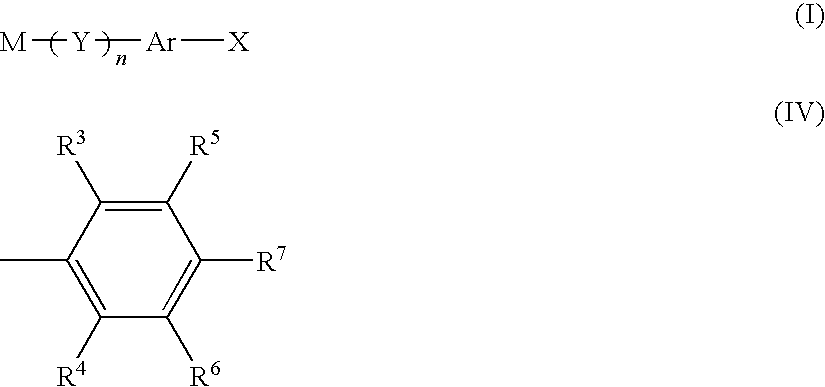Method for producing aromatic polymer
- Summary
- Abstract
- Description
- Claims
- Application Information
AI Technical Summary
Benefits of technology
Problems solved by technology
Method used
Image
Examples
example 1
[0077]A 50 ml egg plant flask was purged with argon, and 0.200 g (0.980 mmol) of pinacol phenylboronate (2), 0.236 g (1.00 mmol) of 1,4-dibromobenzene (1), 0.049 g (0.275 mmol) of anthracene, 15.3 ml of anhydrous THF and 9.8 ml of a 2 M sodium carbonate aqueous solution were added, deaerated using a diaphragm pump while stirring, then, purged with nitrogen. Also a 200 ml three-necked flask was purged with argon likewise, 4.5 mg (0.00491 mmol, 0.5 mol %) of Pd2(dibenzoylacetone)3, 4.3 ml of anhydrous THF and 10 ml of a 2M sodium carbonate aqueous solution were added, deaerated using a diaphragm pump while stirring, then, purged with nitrogen. To this was added, under nitrogen flow, 1.1 ml (0.0122 mmol, 1.2 mol %) of a THF solution of tri-t-butylphosphine adjusted to 2.25 mg / ml, via syringe. Further, mixed liquid of raw materials was added to the three-necked flask by a cannula, and the mixture was stirred at 60° C. for 3 hours. Using gas chromatography, conversion and yield were calc...
example 2
[0080]In the experiment of Example 1, if reactivity with palladium is sufficiently larger for 3 than 1, there is a possibility of generation of mainly 4 even by leaving of palladium. To ascertain this possibility simultaneously, an experiment shown in the following scheme 2 was carried out.
[0081]A 50 ml egg plant flask was purged with argon, and 0.264 g (1.02 mmol) of pinacol t-butylphenylboronate (5), 0.236 g (1.00 mmol) of 1,4-dibromobenzene (1), 0.235 g (1.01 mmol) of 4-bromobiphenyl, 0.061 g (0.359 mmol) of octylbenzene, 15.0 ml of anhydrous THF and 10.0 ml of a 2 M sodium carbonate aqueous solution were added, deaerated using a diaphragm pump while stirring, then, purged with nitrogen. Also a 100 ml eggplant flask was purged with argon likewise, 4.6 mg (0.00503 mmol, 0.5 mol %) of Pd2(dibenzoylacetone)3, 5.0 ml of anhydrous THF and 10 ml of a 2 M sodium carbonate aqueous solution were added, deaerated using a diaphragm pump while stirring, then, purged with nitrogen. To this wa...
example 3
[0083]A 50 ml egg plant flask was purged with argon, and 0.261 g (1.00 mmol) of pinacol t-butylphenylboronate (5), 0.238 g (1.01 mmol) of 1,4-dibromobenzene (1), 0.234 g (1.00 mmol) of 4-bromobiphenyl, 0.266 g (1.56 mmol) of octylbenzene, 15.0 ml of anhydrous THF and 10.0 ml of a 2 M sodium carbonate aqueous solution were added, deaerated using a diaphragm pump while stirring, then, purged with nitrogen. Also a 100 ml three-necked flask was purged with argon likewise, 4.6 mg (0.00503 mmol, 0.5 mol %) of Pd2(dibenzoylacetone)3, 4.9 mg (0.0118 mmol, 1.2 mol %) of 2-dicyclohexylphosphino-2′,6′-dimethoxy-1,1′-biphenyl, 5.0 ml of anhydrous THF and about 10 ml of a 2 M sodium carbonate aqueous solution were added, deaerated using a diaphragm pump while stirring, then, purged with nitrogen. Mixed liquid of raw materials was added to the 100 ml egg plant flask by a cannula, and the mixture was stirred at 60° C. for 3 hours. Using gas chromatography, conversion and yield were calculated from...
PUM
| Property | Measurement | Unit |
|---|---|---|
| Carrier mobility | aaaaa | aaaaa |
| Chemical shift | aaaaa | aaaaa |
| Molecular weight | aaaaa | aaaaa |
Abstract
Description
Claims
Application Information
 Login to View More
Login to View More - R&D
- Intellectual Property
- Life Sciences
- Materials
- Tech Scout
- Unparalleled Data Quality
- Higher Quality Content
- 60% Fewer Hallucinations
Browse by: Latest US Patents, China's latest patents, Technical Efficacy Thesaurus, Application Domain, Technology Topic, Popular Technical Reports.
© 2025 PatSnap. All rights reserved.Legal|Privacy policy|Modern Slavery Act Transparency Statement|Sitemap|About US| Contact US: help@patsnap.com



